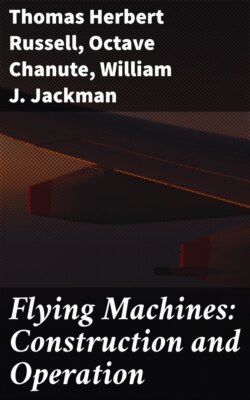Flying Machines: Construction and Operation

Реклама. ООО «ЛитРес», ИНН: 7719571260.
Оглавление
Octave Chanute. Flying Machines: Construction and Operation
Flying Machines: Construction and Operation
Table of Contents
1912
PREFACE
IN MEMORIAM
FLYING MACHINES: CONSTRUCTION and OPERATION
CHAPTER I. EVOLUTION OF TWO-SURFACE FLYING MACHINE
By Octave Chanute
CHAPTER II. THEORY, DEVELOPMENT, AND USE
CHAPTER III. MECHANICAL BIRD ACTION
CHAPTER IV. VARIOUS FORMS OF FLYING MACHINES
CHAPTER V. CONSTRUCTING A GLIDING MACHINE
CHAPTER VI. LEARNING TO FLY
CHAPTER VII. PUTTING ON THE RUDDER
CHAPTER VIII. THE REAL FLYING MACHINE
CHAPTER IX. SELECTION OF THE MOTOR
CHAPTER X. PROPER DIMENSIONS OF MACHINES
CHAPTER XI. PLANE AND RUDDER CONTROL
CHAPTER XII. HOW TO USE THE MACHINE
CHAPTER XIII. PECULIARITIES OF AIRSHIP POWER
CHAPTER XIV. ABOUT WIND CURRENTS, ETC
CHAPTER XV. THE ELEMENT OF DANGER
CHAPTER XVI. RADICAL CHANGES BEING MADE
CHAPTER XVII. SOME OF THE NEW DESIGNS
CHAPTER XVIII. DEMAND FOR FLYING MACHINES
CHAPTER XIX. LAW OF THE AIRSHIP
CHAPTER XX. SOARING FLIGHT
By Octave Chanute
CHAPTER XXI. FLYING MACHINES VS. BALLOONS
CHAPTER XXII. PROBLEMS OF AERIAL FLIGHT
CHAPTER XXIII. AMATEURS MAY USE WRIGHT PATENTS
CHAPTER XXIV. HINTS ON PROPELLER CONSTRUCTION
CHAPTER XXV. NEW MOTORS AND DEVICES
CHAPTER XXVI. MONOPLANES, TRIPLANES, MULTIPLANES
CHAPTER XXVII. 1911 AEROPLANE RECORDS
THE WORLD AT LARGE
NOTABLE CROSS-COUNTRY FLIGHTS OF 1911
CHAPTER XXVIII. GLOSSARY OF AERONAUTICAL TERMS
Footnotes
Отрывок из книги
Thomas Herbert Russell, Octave Chanute, William J. Jackman
A Practical Book Which Shows, in Illustrations, Working Plans and Text, How to Build and Navigate the Modern Airship
.....
This principle is taken advantage of in the construction of all successful flying machines. Makers of monoplanes and biplanes alike adhere to curved bodies, with the concave surface facing downward. Straight planes were tried for a time, but found greatly lacking in the power of sustentation. By curving the planes, and placing the concave surface downward, a sort of inverted bowl is formed in which the air gathers and exerts a buoyant effect. Just what the ratio of the curve should be is a matter of contention. In some instances one inch to the foot is found to be satisfactory; in others this is doubled, and there are a few cases in which a curve of as much as 3 inches to the foot has been used.
Right here it might be well to explain that the word "plane" applied to flying machines of modern construction is in reality a misnomer. Plane indicates a flat, level surface. As most successful flying machines have curved supporting surfaces it is clearly wrong to speak of "planes," or "aeroplanes." Usage, however, has made the terms convenient and, as they are generally accepted and understood by the public, they are used in like manner in this volume.
.....